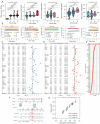Machine learning developed an intratumor heterogeneity signature for predicting clinical outcome and immunotherapy benefit in bladder cancer
- PMID: 39100839
- PMCID: PMC11291408
- DOI: 10.21037/tau-24-5
Machine learning developed an intratumor heterogeneity signature for predicting clinical outcome and immunotherapy benefit in bladder cancer
Abstract
Background: Bladder cancer is a common malignancy with high invasion and poor clinical outcome. Intratumor heterogeneity (ITH) is linked to cancer progression and metastasis and high ITH can accelerate tumor evolution. Our objective is to develop an ITH-related signature (IRS) for predicting clinical outcome and immunotherapy benefit in bladder cancer.
Methods: Integrative procedure containing ten machine learning methods was applied to develop an IRS with The Cancer Genome Atlas (TCGA), gene series expression (GSE)13507, GSE31684, GSE32984 and GSE48276 datasets. To evaluate the performance of IRS in predicting the immunotherapy benefit, we also used several predicting scores and three immunotherapy datasets, including GSE91061, GSE78220 and IMvigor210.
Results: The predicting model constructed with Enet (alpha =0.2) algorithm had a highest average C-index of 0.69, which was suggested as the optimal IRS. As an independent risk factor for bladder cancer, IRS had a powerful performance in predicting the overall survival (OS) rate of patients, with an area under curve of 1-, 3- and 5-year receiver operating characteristic (ROC) curve being 0.744, 0.791 and 0.816 in TCGA dataset. Bladder cancer patients with low IRS score presented with a higher level of immune-activated cells, cytolytic function and T cell co-stimulation. We also found a lower tumor immune dysfunction and exclusion (TIDE) score, lower immune escape score, higher programmed cell death protein 1 (PD-1) & cytotoxic T-lymphocyte associated protein 4 immunophenoscore, higher tumor mutation burden (TMB) score, higher response rate and better prognosis in bladder cancer with low IRS score. Bladder cancer cases with high IRS score had a higher half maximal inhibitory concentration value of common chemotherapy and targeted therapy regimens.
Conclusions: The current study developed an optimal IRS for bladder cancer patients, which acted as an indicator for predicting prognosis, stratifying risk and guiding treatment for bladder cancer patients. Further analysis should be focused on the exploration the differentially expressed genes (DEGs) and related underlying mechanism mediating the development of bladder cancer in different IRS score group.
Keywords: Bladder cancer; immunotherapy; intratumor heterogeneity (ITH); machine learning; prognostic signature.
2024 Translational Andrology and Urology. All rights reserved.
Conflict of interest statement
Conflicts of Interest: All authors have completed the ICMJE uniform disclosure form (available at https://tau.amegroups.com/article/view/10.21037/tau-24-5/coif). The authors have no conflicts of interest to declare.
Figures







References
LinkOut - more resources
Full Text Sources
Research Materials
